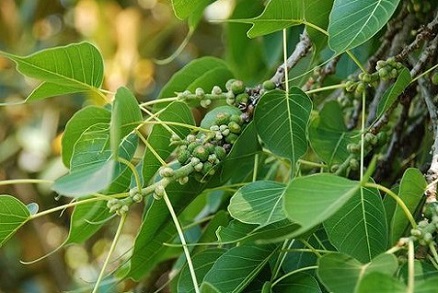Herbs And Phytochemicals: Ficus Religiosa Extracts Could Function As A Sodium Channel Nav1.2 Inhibitor To Treat Epilepsy
Nikhil Prasad Fact checked by:Thailand Medical News Team May 28, 2024 11 months, 2 days, 5 hours, 33 minutes ago
Herbs And Phytochemicals: A Promising New Approach to Epilepsy Management. Epilepsy, a neurological disorder affecting approximately 50 million people worldwide, continues to challenge the medical community. Despite the availability of various antiepileptic drugs, many patients require lifelong treatment and suffer from significant side effects. The search for new treatments with fewer adverse effects is crucial. A collaborative
Herbs And Phytochemicals study by researchers from the University of the Punjab, University of Oulu, and University of Nottingham presents an exciting discovery: Ficus religiosa extracts might serve as sodium channel Nav1.2 inhibitors, offering a novel approach to epilepsy treatment.
 Ficus Religiosa Extracts Could Function As A Sodium Channel Nav1.2 Inhibitor To Treat Epilepsy.
Ficus Religiosa Extracts Could Function As A Sodium Channel Nav1.2 Inhibitor To Treat Epilepsy.
The Role of Sodium Channels in Epilepsy
Epileptic seizures result from abnormal neuronal discharges, often modulated by sodium channels, particularly the Nav1.2 channel. Voltage-gated sodium channels (VGSCs) play a critical role in neuronal excitability by allowing sodium ions to cross cell membranes during depolarization. Dysfunctional sodium channel activity can lead to various disorders, including epilepsy. Inhibiting these channels can help stabilize neuronal membranes and prevent seizures, making VGSCs prime targets for antiepileptic drugs.
The Potential of Ficus religiosa
Ficus religiosa, commonly known as the sacred fig, has been recognized for its medicinal properties in various cultures. Traditionally used to treat ailments like bleeding disorders, digestive issues, and rheumatism, this plant has also shown potential antiepileptic activity in ethnomedicinal practices. The study aimed to explore the plant's phytochemicals and their potential as natural antiepileptic agents.
In Vivo Analysis
The research began with an in vivo approach, using the maximal electroshock (MES) test to evaluate the antiepileptic potential of Ficus religiosa extracts in mice. The MES test, which induces seizures through electrical stimulation, is a widely used model for assessing anticonvulsant drugs. Mice pre-treated with F. religiosa extracts showed a significant reduction in the duration of seizures, indicating the extracts' potential efficacy in controlling epileptic seizures.
In Silico Exploration
Following the promising in vivo results, the study moved to an in silico approach to identify specific compounds in F. religiosa that might inhibit the Nav1.2 channel. Researchers employed advanced computational techniques, including molecular docking, prime molecular mechanics/generalized Born surface area (MM/GBSA) analysis, and molecular dynamics (MD) simulations.
Key Findings from Computational Studies
Out of 82 known compounds in Ficus religiosa, seven demonstrated strong binding affinities to the Nav1.2 channel. These binding affinities ranged from -6.555
to -13.476 kcal/mol, comparable to or exceeding the affinity of phenytoin, a known antiepileptic drug (-6.660 kcal/mol). The top compounds included luteolin 7-O-rutinoside, pelargonidin-3-rhamnoside, and 6-C-glucosyl-8-C-arabinosyl apigenin.
MM/GBSA and MD Simulations
MM/GBSA analysis provided further insights into the binding free energy of these compounds. The most promising compounds, such as kaempferol-3-O-rutinoside, luteolin 7-O-rutinoside, and 6-C-glucosyl-8-C-arabinosyl apigenin, showed the strongest binding energies. Molecular dynamics simulations revealed that pelargonidin-3-rhamnoside and 6-C-glucosyl-8-C-arabinosyl apigenin formed stable complexes with the Nav1.2 channel, indicating their potential as effective antiepileptic agents.
Beyond Binding: Physiochemical and Pharmacokinetic Properties
The study also evaluated the drug-likeness, pharmacokinetics, and toxicity of these compounds. While most compounds exhibited favorable properties, a few, such as luteolin 7-O-rutinoside and kaempferol-3-O-rutinoside, had limitations due to their molecular weight and hydrogen bonding characteristics. However, compounds like pelargonidin-3-rhamnoside and 6-C-glucosyl-8-C-arabinosyl apigenin showed optimal drug-like characteristics, making them suitable candidates for further development.
Discussion and Future Directions
The findings from this study suggest that Ficus religiosa contains phytochemicals with significant antiepileptic potential. The integration of in vivo and in silico approaches provided a comprehensive understanding of how these compounds might inhibit the Nav1.2 channel and prevent epileptic seizures. However, further experimental validation and clinical trials are required to confirm the efficacy and safety of these compounds in human models.
The Road Ahead
This research opens new avenues for the development of natural antiepileptic drugs. The identified compounds could serve as templates for creating more effective and safer medications. Future studies will focus on experimental validation, exploring alternative epileptic models, and assessing the specific antiepileptic properties of these phytochemicals. The potential of Ficus religiosa in epilepsy treatment is promising, and with continued research, it may lead to breakthroughs in managing this challenging condition.
Conclusion
Ficus religiosa, a plant with deep cultural and medicinal significance, shows potential as a source of new antiepileptic agents. By targeting the Nav1.2 sodium channel, compounds from this plant could provide effective and safer alternatives to existing antiepileptic drugs. This study highlights the importance of exploring traditional medicinal plants through modern scientific methods, paving the way for innovative treatments for epilepsy.
The study findings were published in the peer reviewed journal: Brain Sciences.
https://www.mdpi.com/2076-3425/14/6/545
For the latest on
Herbs And Phytochemicals, keep on logging to Thailand Medical News.
Read Also:
https://www.thailandmedical.news/news/single-cell-rna-sequencing-analysis-shows-that-sars-cov-2-is-linked-to-increased-risk-of-mania-and-epilepsy
https://www.thailandmedical.news/news/israel-study-warns-that-seizures-are-a-main-manifestation-of-severe-sars-cov-2-infection-in-children
https://www.thailandmedical.news/news/new-use-for-diamonds-:-brain-inplants-for-treating-epilepsy,-paralysis-and-blindness
